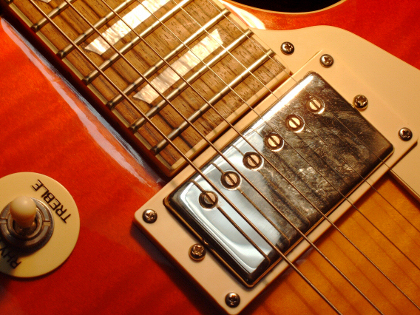
It’s hard to adequetly approximate the effect that the birth of the solid body electric guitar has had on popular music. This innovation, born of a few players’ desire for new sound possibilities, is the main catalyst that made possible everything from the lyrical solos of Pink Floyd’s David Gilmour to the driving metal assault of Slayer, from Jimi’s wailing solos to the chicken pickin twang of James Burton. One of the pioneers of solid body electrics is a man whose name is inextricably linked with the electric guitar: Les Paul.
The first electric guitars were nothing more than acoustic arch-top guitars with pickups on them. Popular with jazz players, these guitars would feed back if turned up too loud. Playing at lower volume was fine if you were playing a small club, but if you wanted to play larger venues—and be able to make more money per gig—you wouldn’t be able to turn your guitar up loud enough to be heard in the back of the room. Another problem was acoustic guitars rely on string vibration for volume. This decreases sustain, that is, the length of time that a note sounds.
These are the problems that Les Paul and others faced. The original Rickenbacker “Frying Pan” lap steel was built to deal with these same issues. And while the solution for the Rickenbacker was to cast the guitar in solid aluminum, Les Paul decided to stick with wood. Taking a 4x4 piece of railroad tie, Paul made what is now called “The Log.” He is famous for having said that you could pluck a note on it, go out to lunch, come back and the note would still be sounding.
Apparently audiences didn’t much like watching a guy play a piece of wood with strings on it. So Paul took an Epiphone archtop, sawed it down the middle and mounted the two halves on either side of the log. This made the instrument far more recognizable as a guitar and, one would imagine, a little more comfortable to play.
In the early fifties, Gibson Guitar Company produced a solid-body electric guitar based on suggestions that Paul had given. This guitar received his endorsement and became the guitar to bear his name. The Les Paul model has seen many changes since that time. When sales declined, Gibson redesigned the Les Paul (without Paul’s endorsement) into a thinner, double cutaway guitar. Paul didn’t want his name associated with it and it thereafter became known as the SG (get it, Solid Guitar?).
When the original Les Pauls gained more popularity due to being seen in the hands of several rock luminaries, Gibson started making them again, with the blessing of Les Paul, and it has been a consistent seller since then. It is an instantly recognizable shape that shows up in popular culture and art and seems to be inextricably linked to Rock and Roll.
So next time you pick up your Les Paul, whether it be a 52 Goldtop or a budget knockoff version you bought at a yard sale, be grateful for the guy whose name is on your guitar. Then turn it up, that’s why he made it.
If you have any questions, comments, or concerns, please contact us.